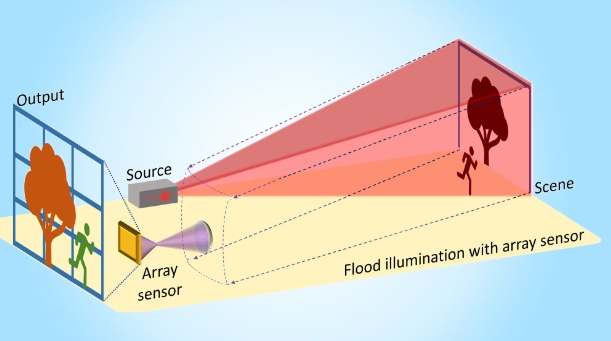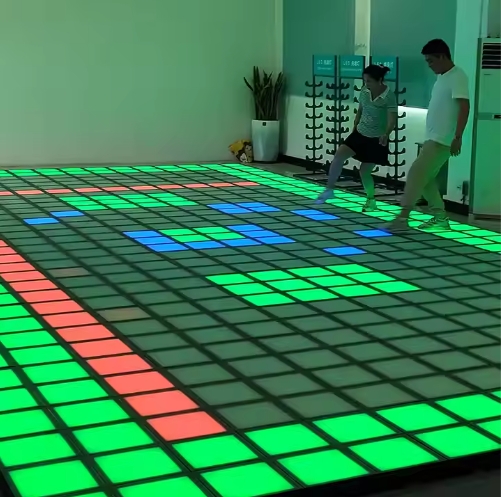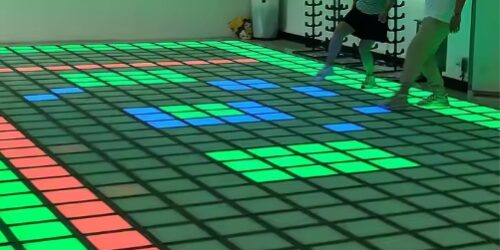Introduction
Ground interactive projection systems have transformed spaces across entertainment, retail, education, and public installations, allowing users to engage with digital content displayed on the floor in real time. A critical factor for seamless interaction is the accuracy and responsiveness of the system, especially when it involves tracking multiple users. Here, LiDAR (Light Detection and Ranging) technology plays an essential role, providing high precision and rapid response times that ensure a smooth, immersive user experience. In this article, we’ll dive into how LiDAR enhances accuracy and reaction speed in ground interactive projection, elevating user engagement and creating a more interactive environment.

The Role of Accuracy and Responsiveness in Interactive Projection
For any interactive projection system, accuracy and responsiveness are key to achieving a natural interaction experience. These two factors impact:
- Interaction Precision: The system must accurately detect users’ exact positions and movements.
- Real-Time Feedback: Interaction should feel instantaneous, with little to no delay, to maintain immersion.
- Multi-User Tracking: In public spaces, the system must reliably track multiple users simultaneously, which demands both high accuracy and rapid response times.
Without these, interactions can feel clumsy, with slow or incorrect responses breaking the sense of immersion. This is where LiDAR technology excels, providing unparalleled accuracy and speed.
How LiDAR Enhances Precision in Ground Interactive Projection
LiDAR uses laser pulses to measure the distance between the sensor and objects in the environment, producing a detailed 3D map. This depth information allows the system to achieve a new level of precision in tracking movements on the projection surface.
1. High-Resolution Depth Mapping
Unlike standard cameras that capture two-dimensional images, LiDAR generates precise 3D data of its surroundings, measuring distances with millimeter accuracy. In a ground interactive projection system, this high-resolution depth data allows LiDAR to differentiate between multiple users’ movements and determine their exact positions on the interactive floor. This precision enhances the overall accuracy, ensuring that each user’s interactions are correctly captured and reflected in real-time projections.
For instance, in a retail environment, this high-precision tracking ensures that customers walking through the projection will see visuals respond directly underfoot, without delays or misalignment, creating a seamless interactive experience.
2. Multi-User Distinction
LiDAR technology can differentiate between multiple people on the projection surface, even in crowded spaces. By using depth mapping, LiDAR can isolate each user’s movements independently, ensuring that each individual’s interactions trigger the intended response without interference from nearby users.
In a museum exhibit, for example, LiDAR’s accuracy allows multiple visitors to explore an interactive projection without the system confusing their interactions. This capability is essential for public settings where multiple users may engage simultaneously, maintaining the system’s functionality and user satisfaction.

How LiDAR Improves Responsiveness for Real-Time Feedback
Beyond accuracy, LiDAR enhances the responsiveness of interactive projection systems. Real-time feedback is critical for user engagement, as delays between a user’s action and the system’s response disrupt immersion. LiDAR’s ability to provide continuous, rapid updates allows for smooth, instantaneous interactions.
1. High-Speed Data Processing
LiDAR sensors deliver data at high refresh rates, meaning the system can capture and process movements almost instantaneously. In interactive projection, this high-speed data processing ensures that each movement, step, or gesture is translated to the projection surface in real time.
In an entertainment setup, for instance, when a player “kicks” a virtual soccer ball on the floor, the system responds instantly, moving the ball in sync with the player’s foot movement. This level of responsiveness enhances immersion, keeping users engaged without interruptions.
2. Reduced Latency
By capturing depth data directly, LiDAR eliminates the need for complex calculations that traditional vision systems may require, reducing latency significantly. This low-latency performance is vital in interactive applications, as even a short delay can break the sense of presence and engagement.
In applications such as interactive floor games or live performances, where immediate response is crucial, LiDAR’s low-latency feedback ensures that every step, jump, or gesture is mirrored in the projection without delay, creating a more realistic and satisfying user experience.
Practical Benefits of LiDAR-Enhanced Precision and Responsiveness
The precision and real-time capabilities of LiDAR offer several advantages for ground interactive projection systems, improving the user experience in various ways:
- Enhanced Immersion: Accurate, real-time feedback keeps users engaged and immersed in the experience, allowing them to focus on the interaction without distractions caused by delayed responses.
- Increased User Satisfaction: The system’s ability to differentiate and track multiple users accurately ensures a smooth experience, even in crowded settings, improving overall satisfaction.
- Versatility Across Environments: LiDAR’s robustness in various lighting conditions and its adaptability to different layouts make it an ideal solution for interactive installations in public, retail, and entertainment spaces.
Real-World Applications of LiDAR-Driven Precision and Responsiveness
With LiDAR’s advantages in accuracy and speed, ground interactive projection systems have excelled across several industries:
- Education: In educational settings, where interactive floors offer children an engaging way to learn, LiDAR enables precise tracking of each child’s movements, ensuring that educational games respond accurately, enhancing both learning and play.
- Retail: Retailers use interactive projection floors to attract and engage customers. LiDAR’s accuracy allows the system to respond instantly to shoppers’ movements, displaying promotions or product information as they move, making the experience both informative and entertaining.
- Public Events: In large-scale events or exhibitions, LiDAR’s ability to handle multiple users and provide immediate responses makes it perfect for crowd interaction, ensuring each visitor’s experience is personal and seamless, even in high-traffic spaces.
Conclusion
LiDAR technology is a game-changer for ground interactive projection systems, providing the high precision and real-time responsiveness needed for an immersive, engaging user experience. By enabling accurate multi-user tracking and low-latency responses, LiDAR ensures that every movement is captured and displayed on the projection surface with incredible accuracy, whether it’s a ripple effect, a collision, or a visual reveal.
As interactive technology continues to evolve, LiDAR’s precision and responsiveness will play a central role in delivering seamless interactions, making these systems more captivating and versatile across industries. Whether in entertainment, education, or retail, LiDAR-enhanced ground projection systems are setting new standards for engagement, transforming physical spaces into interactive, dynamic environments.
This guide offers an in-depth understanding of how LiDAR brings unmatched precision and responsiveness to ground interactive projection systems, enabling them to deliver immersive and interactive experiences that capture the interest of audiences across industries.







